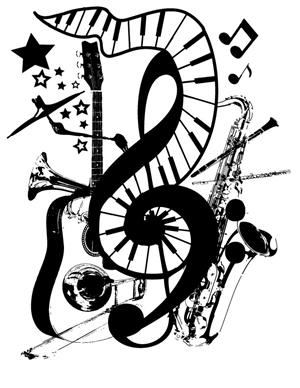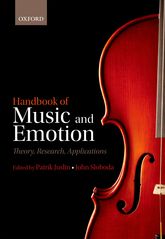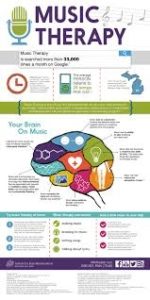
Music is not only a popular form of entertainment, it can also teach, pass on information, highlight problems, and motivate people. This lesson will address the ways that people produce songs to express messages and meanings about shared experiences through stories, statements, and metaphors in words and music.
Lesson Objectives
- identify how music and lyrics communicate meanings and emotions.
- recognize the relationship between music and culture
- describe the difference between music appropriation and misappropriation
- evaluate the social or cultural significance of a song through lyrical analysis
Music & Emotion
Music is one of the common cultural phenomenons that connects people across all borders of nationality, race, and culture. It arouses common emotions and feelings, that are far more powerful than language. The psychological influence of music on human emotion has received significant attention from several areas of study in psychology, musicology, and music theory in order to understand the nature of emotional reactions to music and to identify which components of a musical composition or performance may elicit certain reactions. There has been an increased interest in understanding how the brain processes musical emotion.
According to Patrick Juslin in The Handbook of Music and Emotion, music creates a perceptual illusion, in the same way the mind perceived a collage. The brain automatically imposes structure and order on a sequence of sounds and that process creates a new system of meaning that is based on the sum of the collective parts. Appreciating musical aesthetic is linked to the brain’s ability to process the underlying structure of the musical piece and to predict what sound will come next. Skilled composers and songwriters know how to manipulate the emotion with a song by either knowing what their audience will expect expectations and controlling when those expectations will (or will not be) achieved.
Music appreciation and composition is rooted in the primitive brain structures involved in motivation, reward and emotion. The brain synchronizes neural oscillators with the pulse of the music to predict when the next sound will occur. This is a primarily unconscious process taking place in the cerebellum and amygdala rather than the frontal lobes. Since music involves subtle violations of timing that are not threatening, the violations are identified by the frontal lobes as pleasure. The expectation creates anticipation, and when the expectation is achieved, it creates a reward reaction in the brain.
Music also plays on the imagination. It has the ability to conjure images and feelings that do not come from memory, and the overall experiences retains mystery; this is what creates the ‘thrill’ of listening to music. Synesthesia is a perceptual phenomenon in which one sensory stimulus leads to automatic, involuntary experience in a second sensory or cognitive pathway. This is how composers couple sound with other elements such as color, imagery, and emotion.
Music & Culture
Music is a performative expression of culture. From the nature of the sound arrangements and the instruments used to create the sound, to the performers offering the performance; music and song is a cultural arrangement of sound and lyrics that reflect the unique histories and experiences of the people from which the arrangement emerges. since music is heard rather than read, the messages and meanings carried in music can reach a much larger audience than text-based literature.
In the reggae music created by Bob Marley, for example, Marley was able to deliver elements from rastafarian religion, social and historical experiences in Jamaica, and his personal vision to bring peace, justice and unity to the world by packaging his message into melodies that carried his voice worldwide. Watch the first episode of the documentary, ‘Legacy: 75 Years a Legend,’ about the music life and work of Bob Marley. Consider the ways that Bob Marley delivered messages and meanings about religion, culture, philosophy and Jamaican experiences in his music.
Ethnomusicology
Ethnomusicology is the study of music in its cultural context. Ethnomusicologists approach music as a social process in order to understand not only what music is but why it is: what music means to its practitioners and audiences, and how those meanings are conveyed. Ethnomusicology draws from a wide range of disciplines. Ethnomusicologists may be trained in music, cultural anthropology, folklore, performance studies, dance, cultural studies, gender studies, race or ethnic studies, area studies, or other fields in the Humanities. Yet all ethnomusicologists share a coherent foundation in the following approaches and methods:
-
Taking a global approach to music (regardless of area of origin, style, or genre).
-
Understanding music as social practice (viewing music as a human activity that is shaped by its cultural context).
-
Engaging in ethnographic fieldwork (participating in and observing the music being studied, frequently gaining facility in another music tradition as a performer or theorist), and historical research.
The interconnected relationship between music and culture, the ways that songs reflect unique and shared human experiences, and the universal appreciation of music makes music a cross-cultural window connecting people and humanity. By singing together, humans can participate in sharing a meaningful experiential activity that creates pleasure, social bonding, and connectedness among friends, family, and even strangers.
At the same time however, the cultural significance of music, particularly among marginalized and oppressed populations, demands ethical considerations for singers, composers, and listeners. Music and songs may have sacred or special meaning, purpose, and/or role in the society or culture it comes from. Misappropriation, or cultural appropriation, occurs when a person or group takes something culturally significant from another group in order to perform, modify, or adopt for their own personal, private, or commercial purposes. Misappropriation fails to honor and respect the culture and music of disempowered groups.
One famous example of misappropriation is the song ‘Wimoweh’/’The Lion Sleeps Tonight’ in the United States. It was originally composed as ‘Mbube’ in South Africa, and transcribed in 1951 by Pete Seeger, a popular American folksinger. It became a pop hit in the 1960s whenit was performed by ‘The Tokens’ on television, and over the course of a few decades it was appropriated by several artists and eventually became an integral part of Disney’s The Lion King. While the song generated millions of dollars in revenue for American singers and filmmakers, the original South African Zulu producer of the song, Solomon Linda, never received any compensation; he died penniless in South Africa. Watch the documentary trailer below, and visit The Lion’s Trail by Independent Lens.
The Mbube/Wimoweh/Lions Sleeps story is only one of thousands of instances where indigenous culture has been misappropriated. There is a growing movement to reclaim cultural artifacts and restore their cultural significance within the appropriate social and historical context.
Analyzing Song in the Humanities
Song analysis draws from the same literary analytical techniques as the elements or poetry, yet it also requires investigating the additional emotional layer provided by sound.
Step 1: Select an original, meaningful song and listen to it. Consider the sound and the emotional depth of the lyrics (if any), the themes and issues it introduces and its creative use of language (music and words.)
Step 2: Investigate the social and historical context of the song: include the songwriter, year and any events that that shaped its creation. Listen to it again and consider how the sound and overall theme of the lyrics (if any) tie into a specific event, topic, issue or experience?
Step 2: Read, analyze and interpret the lyrics (if any) by applying the elements of fiction and/or poetry.
Step 3: Create an horizontal time line that maps out the lyrics and the music; Identify the instruments and how are they used. Mark the flow and beat change. Insert the meanings and emotions you feel along the timeline. Consider the ways that the music (sound and silence) emphasizes or changes lyrical meaning. Underline or highlight important musical points in the song and note how sound contributes to its meaning and/or emphasizes the lyrics.
Step 4: After mapping out the song, listen to the song one last time and use the new information from your analysis to develop your overall impression of the song. What is the main theme? How does it connect people? What can you and others take away from it?
Music in the Humanities
Music and song is a great way to learn about the world view of a different culture and it can also connect individuals through shared experiences across cultures. Sound and vibrations provide non-literal ways to communicate emotion and it can also add or change the emotional impacts of the spoken word. Through music people can tell stories, shares experiences and connect through time and across space.
Questions to Consider for In-Class Discussion
- In what ways can music, or sound, communicate meanings such as feelings and emotion?
- How does the field of ethnomusicology connect music to culture?
- What is the difference between appropriation and the misappropriation of songs?
References and Resources
To learn more about song, music and the humanities, explore the links below.
- The Cultural Connection Unitarian Universalist Association
- Afropop Worldwide: an internationally syndicated weekly radio series, online guide to African and world music, and an international music archive, that has introduced American listeners to the music cultures of Africa, Latin America and the Caribbean since 1988.
- World Music Network: a UK-based record label specializing in world music. The World Music Network website features news, reviews, live music listings, and guide sections on world music. It also features an online “Battle of the Bands” competition.
- Florida Folklife: Music in State Archives
- Folk Cloud: Archive of worldwide folk music
- Bartin, Georgina. 2018. Chapter 2: The relationship between music, culture and meaning
- Society of Ethnomusicologists.
- Walsh, Ashley. 2013. A great heathen fist from the North: Vikings, Norse Mythology, and Medievalism in Nordic Extreme Metal. Trykk: Reprosentralen, University of Oslo
For Discussion in Canvas
Select a ‘culturally significant’ song (this can be any song that communicates shared meanings and messages) and post a link to a video or mp3 to the song in the discussion. Map and analyze the song using the four-step framework introduced in this lesson. Embed an image of your song map accompanied with a 50-100 word response to step four. Respond to at least two other student posts to compare and/or contrast your findings.
For Journal Expression
Write a song (music with or without lyrics) and upload it to the discussion (video or mp3) with your song map and a brief (approx 50-word) explanation of the lyrics (if any). Describe how you chose the music to create meaning and emotion. You can collaborate with friends, family or your classmates or go at it alone. Post the lyrics (if any) and interpret them for the listener. If there are no words, then interpret the meanings behind the sound.
Post a video of you or a friend performing the song or you can make a music video using imagery to enhance the meanings. If you do not feel comfortable singing or performing in front of the camera, be creative and devise alternatives; nature sounds, distortion, sampling, video filters (ie tik tok), etc. This is where you are being challenged to dig deep into your right brain for inventive and innovative ideas. As always, provide feedback to at least two other student songs. (If your video is too large, you can upload to a third party like youtube, but be sure it is not set on ‘private.’)
Take Note: You can collaborate with one or more classmates in this activity as well as in the upcoming dance activity. You can also use this song for your dance activity. If you choose to collaborate with a classmate(s) or combine your song and dance, you can upload the same video, but write separate descriptions about your individual intent and purpose in the piece. Identify what each of you contributed to the song or dance and why. Feel free to reflect also on the experience of creative collaboration with others.)
Songwriting Resources:
- Video: How to Write Great Lyrics
- Video: Hip Hop Songwriting Tips
- Sound Radar: The Best Free Music Samples and Downloading Sites
- Royalty-Free Music by Bensound
- Garageband for Mac
- Soundation Online Music Maker
- Beepbox digital sound maker
- Soundtrap Free Music Maker by Spotify
Note: It is your responsibility to ensure that your song file can be heard or viewed. If you are uploading a video or MP3, be sure it is small enough to be viewed. It may be easier to upload the file to Youtube and submit the link to Canvas. If you use a third-party host, like Youtube, be sure the account is viewable to the public.


